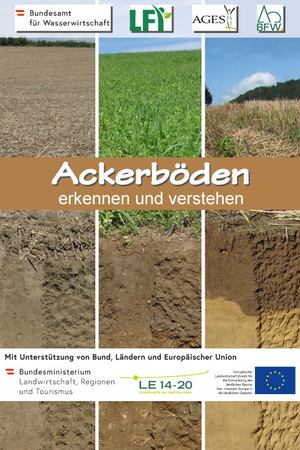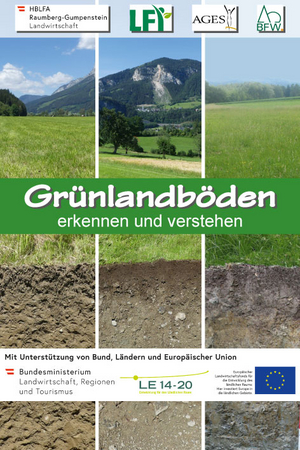Bottom compartments
The fertility of soils is in our hands. The newly developed identification trays for arable soils and grassland soils, as well as six topic-specific "soil discs" and an app, are available to farmers to help them better identify their soils and assess their properties. This is a prerequisite for sustainable soil management! Thanks to their handy format, these materials are also suitable for use in the field.
The soil fans allow (easy) identification of soil types and properties, contain basic pedological information, and offer concrete management recommendations adapted to the performance of the site.
These tools, supplemented by the educational materials presented here, are aimed at farmers and can be used by multipliers (teachers, stakeholders, advisors), as well as by the "farmers of the future", agricultural students and students. The products were created in cooperation of BFW, AGES, LFI, ÖBG, HBLFA Raumberg-Gumpenstein and BAW in the framework of the Rural Development Program 14- 20 in the funding measure "Knowledge Transfer and Information Measures in Agriculture and Forestry", with the support of the Federal Government, the Länder and the European Union in the project M1a-210/19.
Application of the bottom compartments
The core of the soil compartments is formed in each case by a key for determining the soil type, divided into six simple questions, as well as clear descriptions of the individual soil types (red-coded section). If you want to determine the soil type of an arable or grassland soil, go through the questions of the determination key one after the other until you land at a soil type and the description of its characteristics. If a question is unclear, you will find the necessary background knowledge in the notes next to the respective question or in the section coded in blue. In this section you will also find definitions of soil horizons and explanations of how to determine the most important soil properties and soil characteristics. In the purple section you will find practical examples for assessing important soil properties and examples of indicator plants. A glossary at the end of the soil compartments further adds to their ease of use.
The six soil panes are used to assess and prevent relevant soil hazards. In arable land, these are erosion, nitrate discharge and compaction, and in grassland, yield potential, weeds and compaction are addressed. Based on local soil and management parameters, a traffic light system can be used to assess the risks of soil hazards and derive measures for prevention and remediation.
Essential contents of the soil fans are also offered as a web app for smartphone, tablet and PC. Theapp provides flexible and interactive access to the content. Aquiz can be used to consolidate and expand one's own soil knowledge and understanding of interrelationships in a playful way. This is also in line with the focus on digitization in the new Common Agricultural Policy (CAP).
Educational materials on agricultural soil subjects
In order to provide an overview of the most important soils in arable land and grassland, we have created two quick identification keys. In the quick identification key for the arable soil fan, you get an overview of the 18 most important soil types under arable land on one page and in the quick identification key for the grassland soil fan, you get an overview of the 12 most important soil types in grassland. In both cases, you can determine the soil type in question by answering the questions in order for your location.
In a catena, the characteristic sequence of soils in a landscape is depicted, which results from rearrangement processes along a slope. In nature, many transitions and a greater variety occur than in schematic representations. Nevertheless, catenas are well suited to illustrate the formation of different soils, which depends on parent material, relief position, and water balance, among other factors. Worksheets and assignments are available for each of the four catenas below.
Soil type, along with soil skeleton and humus content, is one of the most important soil properties and has a major impact on the water, air, heat and nutrient balance as well as the workability of a soil. Soil type significantly influences the pore volume and thus the water holding capacity of a soil. This is also called field capacity and indicates how much water a soil can store. The soil type also determines the distribution of pore sizes and thus the water availability for plants, the so-called usable field capacity.
Soil type also influences nutrient storage and availability: the finer the grain size, the greater its internal surface area and thus its sorption capacity (the ability of a soil to bind ions reversibly). The rootability and temperature balance of a soil also depend on the soil type. In addition, the soil type is a significant factor for the erosion susceptibility and workability, especially the trafficability or the compaction risk of a soil.
The soil type is always determined from the fine soil, which is the material with a grain size of less than 2 mm, either in the laboratory or with the finger sample in the field or grassland. The arable and grassland soil fan can be used to approximate soil type by answering a few questions.
The digital soil map (eBod) presents the soil conditions of Austria's agricultural land. In the web application, one can retrieve all site properties as well as graphical representations of soil forms and their typical properties and horizons. With the help of thematic maps, various soil properties can be explored and interpreted. The digital soil map thus provides a comprehensive insight into agriculturally used soils and can provide important information, e.g. for cultivation.
Soil life is the core of a fertile soil and requires special attention. Soil organisms contribute to agricultural productivity and are responsible, among other things, for the processing of nutrients. The diversity of living organisms in a healthy soil ranges from the smallest unicellular organisms (e.g. bacteria, algae, fungi) to nematodes and springtails to earthworms, insects and small vertebrates. Knowing and caring for the soil life in your field also means promoting soil health and productivity.
The methods listed here support the assessment of soil condition and provide a basis for decisions regarding agricultural management. Changes in soil properties can be detected when the tests are repeated and / or when the results are compared with those of a reference soil from a field plot with different management (e.g. different fertilization, different tillage). In case of major changes in management, a soil analysis should be carried out in the laboratory.
The spade test is probably the most important method for assessing the condition of the soil directly in the field. Among other things, soil structure, rooting, activity of soil organisms and potential compaction phenomena can be recorded. Based on repeated performance of the spade test, changes over time can be detected and tillage, fertilization and crop rotation can be optimally adjusted.
A soil test provides values about important soil properties and should be carried out regularly, at least before and after major management changes. Knowledge of the current nutrient supply, for example, is the basic prerequisite for efficient fertilization and thus for environmentally friendly and cost-saving management.
Soils are non-renewable resources and are subject to various hazards, mainly resulting from multiple land use demands. Many hazards can be prevented or repaired through properly selected management practices. The soil discs and information sheets are designed to increase knowledge and awareness of selected hazards and prevention strategies. The worksheets include example scenarios to be evaluated with the respective soil disks.
Field
- Erosion Info sheet
- Soil Compaction Field Info Sheet
- Nitrate Discharge Info Sheet
- Worksheet arable soil slices
- Solutions to the Worksheet Arable Soil Slices
Grassland
The soil compartments and associated educational materials provide a variety of information, guidance, and examples for learning about and understanding important soil properties. This workshop design incorporates several modules for designing workshops with different focuses. Individual modules can also be integrated into existing courses or teaching units.
These PowerPoint documents contain all pages of the floor compartments and can be used for presentations in schools, workshops, training courses, etc.
Reproduction for sale is prohibited. The trays and ring binders can be ordered from the BFW webshop at www.bfw.ac.at/webshop.
Last updated: 25.05.2023
automatically translated


